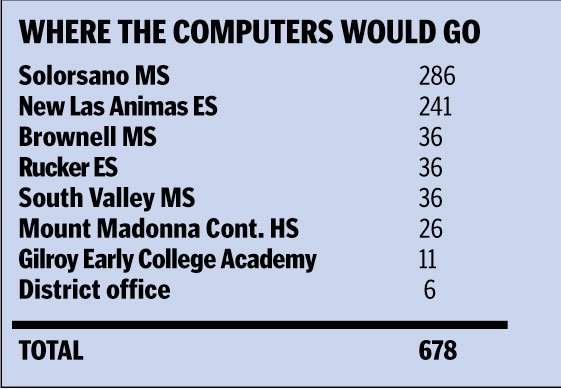The new elementary and accelerated high schools will open this
fall equipped with a number of new technologies
– but computers might not be one of them.
Gilroy – The new elementary and accelerated high schools will open this fall equipped with a number of new technologies – but computers might not be one of them.
The installation of computers at the new Las Animas Elementary School and the Gilroy Early College Academy could be delayed more than a month because of concerns from the Gilroy Unified School District board of trustees about the effectiveness of technology in the classroom.
The board spent two hours at Thursday night’s meeting debating whether to spend $476,470 to purchase 678 computers for the district and seven schools, including 241 at Las Animas and 11 at the early college academy. With one trustee absent, the board was split 3-3 and the resolution stalled.
“I just feel like more computers in the classroom may not add to instruction, it may take away from instruction,” trustee Denise Apuzzo said.
Fellow opponent to the resolution and board president Tom Bundros, cited a report released by the U.S. Department of Edcation in March that showed no correlation between educational software use and higher achievement on tests.
However, the study also reported that schools did not use the software as often as suggested by the manufacturers or back it up with professional development, said Christine Carter, superintendent of the Reed Union School District in Marin County. The kindergarten-eighth grade district is at the forefront of integrating technology in the classroom. Two years ago they equipped all 336 students at its middle school with laptops to use in every class.
The technology has “absolutely” been a sound investment, she said. In addition to allowing teachers to instruct in novel and engaging ways, students gain computer skills that allow them to vie for jobs in a competitive global market.
“If our kids are still pressing paper and pencils, how are we going to compete,” she said. “Our job is not to create the world we grew up in. Our role is to create the world that our kids are going to grow up in.”
Apuzzo, Bundros and trustee Rhoda Bress, who all voted against the resolution, were not as convinced that technology was a positive influence in the classroom and wanted proof from district staff and administrators that computers have added to student achievement in Gilroy. They suggested they discuss this topic, and how the district would pay to replace computers after they become obsolete in five years, at a separate meeting.
“We’re spending half a million dollars here,” said Bundros, a software engineer at Hitachi Global Storage Technologies. “I suggest we have a study session to go through that before we buy any more technology.”
If the board waits to make a decision until after its next retreat and study session-slated for late July – when the new superintendent has settled into her job – installation of the computers could come as late as October. The board originally directed district staff to solicit bids for the computer purchase in March.
If the board doubts the value of technology and how to fund it, trustees should have discussed it in March, said trustee Javier Aguirre, who voted for the resolution along with trustees Jaime Rosso and Pat Midtgaard. Voting against the resolution penalizes schools for the board’s shortsightedness, he said.
“We dropped the ball as a board,” he said. “While these concerns are valid, I think the timing is crucial.”
Spurred by Aguirre, the board voted 4-1 to bring the resolution back at a July 5 meeting when all seven trustees, including Francisco Dominguez, will be present. Even if the board passes the resolution then, the installation of the computers at the schools – including at the new Las Animas, which cannot be fitted with the obsolete equipment from the old site – could be delayed until mid-September.
The resolution calls for about $270,000 of the money to come from funds distributed by the state after it reached a settlement in 2004 with Redmond, Wash.-based Microsoft Corp. and earmarked for computer hardware. The majority of the remaining $200,000 would draw from specific school site, categorical and facilities budgets. About $12,000 would come from the district’s general funds.
While split regarding the expenditure, trustees reached consensus that they were at fault and should have discussed the value of technology earlier and apologized to staff and school administrators.
“I apologize, but this is a discussion we should have been having over the course of the last four or five years,” Bundros said.














